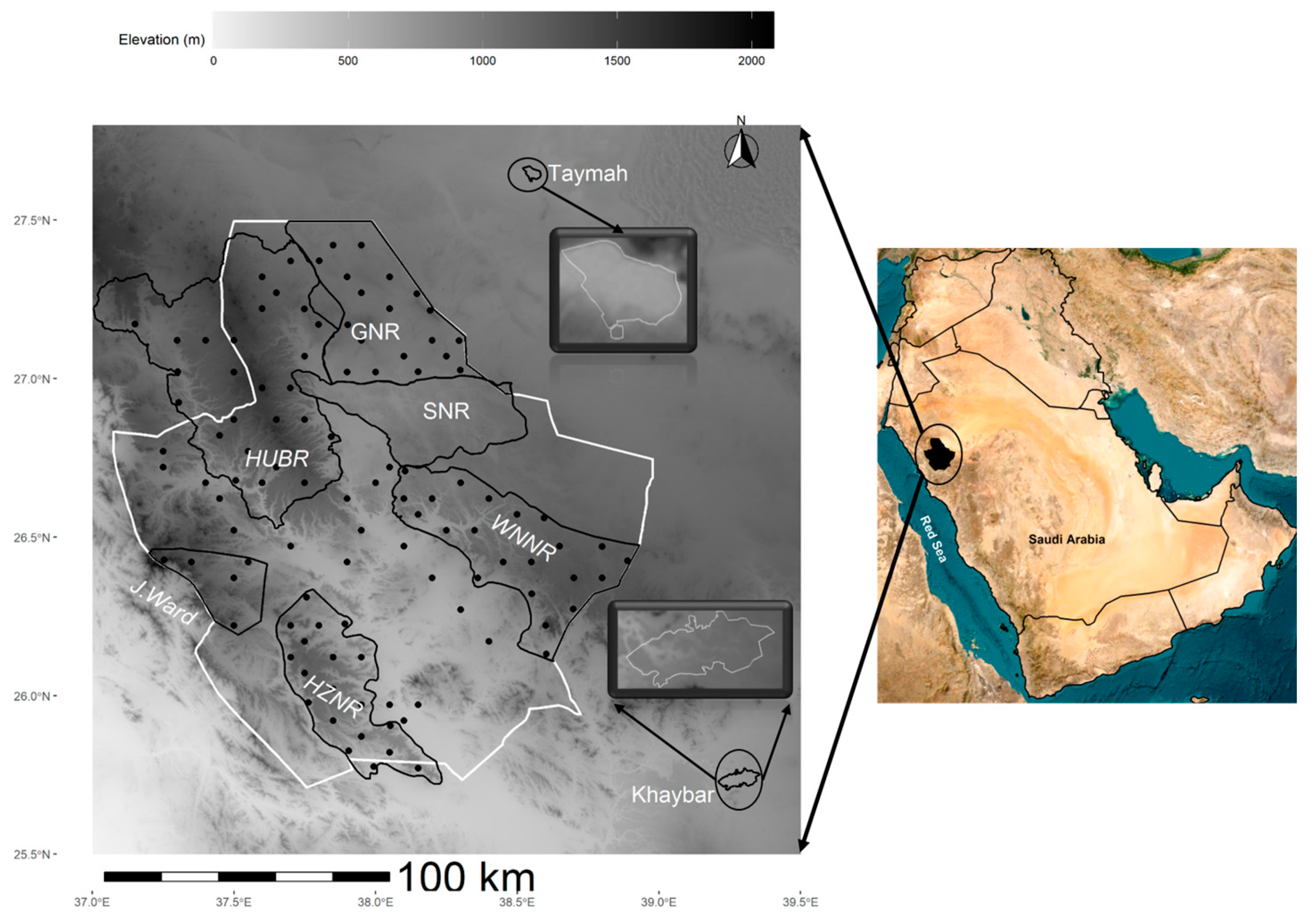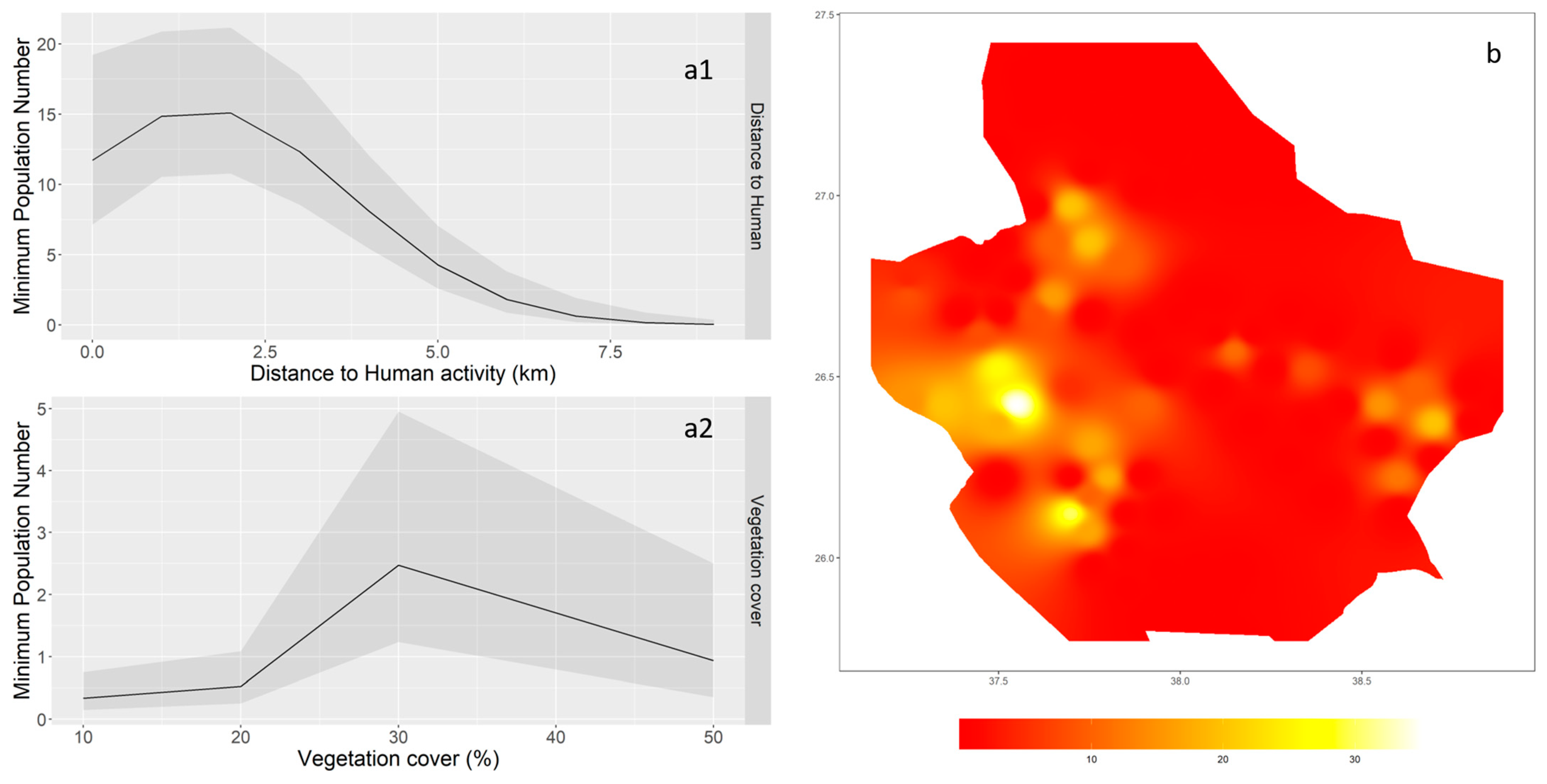Feral Donkey Distribution and Ecological Impacts in a Hyper-Arid Region
Abstract
:Simple Summary
Abstract
1. Introduction
2. Materials and Methods
2.1. Study Area
2.2. Data Collection and Analysis
3. Results
4. Discussion
5. Conclusions
Author Contributions
Funding
Institutional Review Board Statement
Informed Consent Statement
Data Availability Statement
Acknowledgments
Conflicts of Interest
References
- Meutchieye, F.; Kwalar, N.N.; Nyock, R.A.F. Donkey Husbandry and Production Systems. In Current Donkey Production and Functionality: Relationships with Humans. Book 1; González, F.J.N., Delgado, J.V., Burgos, J.C.V., Eds.; UcoPress: Córdoba, Spain, 2016. [Google Scholar]
- Schoenecker, K.A.; King, S.R.B.; Nordquist, M.K.; Nandintsetseg, D.; Cao, Q. Habitat and Diet of Equids. In Wild Equids: Ecology, Management, and Conservation; Ransom, J., Kaczensky, P., Eds.; Johns Hopkins University Press: Baltimore, MD, USA, 2016; pp. 41–57. [Google Scholar]
- Turnbull, A.; Wernery, U.; Wernery, R.; Anandh, J.P.; Kinne, J. Survey of Six Infectious Diseases of Feral Donkeys in the United Arab Emirates. Equine Vet. Educ. 2010, 14, 33–38. [Google Scholar] [CrossRef]
- Global Invasive Species Database (GISD) Species Profile Equus asinus. Available online: http://www.iucngisd.org/gisd/species.php?sc=639 (accessed on 29 August 2023).
- Yılmaz, O.; Boztepe, S.; Ertuğrul, M. The Domesticated Donkey: I—Species Characteristics. Can. J. Appl. Sci. 2012, 4, 339–353. [Google Scholar]
- Gichure, M.; Onono, J.; Wahome, R.; Gathura, P. Assessment of Phenotypic Characteristics and Work Suitability for Working Donkeys in the Central Highlands in Kenya. Vet. Med. Int. 2020, 2020, 8816983. [Google Scholar] [CrossRef] [PubMed]
- Pearson, R.A.; Ouassat, M. Estimation of the Liveweight and Body Condition of Working Donkeys in Morocco. Vet. Rec. 1996, 138, 229–233. [Google Scholar] [CrossRef]
- Cappai, M.G.; Picciau, M.; Pinna, W. An Integrated Approach towards the Nutritional Assessment of the Sardinian Donkey: A Tool for Clinical Nutritionists. Ital. J. Anim. Sci. 2013, 12, e29. [Google Scholar] [CrossRef]
- Brinkmann, K.; Patzelt, A.; Dickhoefer, U.; Schlecht, E.; Buerkert, A. Vegetation Patterns and Diversity along an Altitudinal and a Grazing Gradient in the Jabal Al Akhdar Mountain Range of Northern Oman. J. Arid Environ. 2009, 73, 1035–1045. [Google Scholar] [CrossRef]
- Mohamed, W.F. Negative Effects of the Feral Donkey Equus asinus (Linnaeus, 1758) in Al-Ula Governorate, Western Saudi Arabia. Kuwait J. Sci. 2021, 49, 1–12. [Google Scholar] [CrossRef]
- FAO FAOSTAT. License: CC BY-NC-SA 3.0 IGO. Available online: https://www.fao.org/faostat/en/#data/QCL (accessed on 20 May 2022).
- Vetter, S. Investigating the Impacts of Donkeys on a Communal Range in Namaqualand: How Much Does a Donkey “Cost” in Goat Units? Bachelor’s Thesis, University of Cape Town, Cape Town, South Africa, 1996. [Google Scholar]
- Samuels, M.I.; Allsopp, N.; Hoffman, T. Mobility Patterns of Livestock Keepers in Semi-Arid Communal Rangelands of Namaqualand, South Africa. Nomad. People 2008, 12, 123–148. [Google Scholar] [CrossRef]
- Muller, H.; Bourne, A. Minimum Population Size and Potential Impact of Feral and Semi-Feral Donkeys and Horses in an Arid Rangeland. Afr. Zool. 2018, 53, 139–144. [Google Scholar] [CrossRef]
- Burrows, N.D. Feral Animals in the Semi-Arid and Arid Regions of Australia: Origins, Impacts and Control. In On the Ecology of Australia’s Arid Zone; Springer International Publishing: Cham, Switzerland, 2018; pp. 331–373. [Google Scholar]
- Perry, N.D.; Morey, P.; Miguel, G.S. Dominance of a Natural Water Source by Feral Horses. Southwest. Nat. 2015, 60, 390–393. [Google Scholar] [CrossRef]
- Hall, L.K.; Larsen, R.T.; Westover, M.D.; Day, C.C.; Knight, R.N.; McMillan, B.R. Influence of Exotic Horses on the Use of Water by Communities of Native Wildlife in a Semi-Arid Environment. J. Arid Environ. 2016, 127, 100–105. [Google Scholar] [CrossRef]
- Buckland, S.T.; Anderson, D.R.; Burnham, K.P.; Laake, J.L. Distance Sampling. In Encyclopedia of Biostatistics; John Wiley & Sons, Ltd.: Chichester, UK, 2005. [Google Scholar]
- Rudman, R. The Social Organisation of Feral Donkeys (Equus asinus) on a Small Caribbean Island (St. John, US Virgin Islands). Appl. Anim. Behav. Sci. 1998, 60, 211–228. [Google Scholar] [CrossRef]
- Hamrick, R.G.; Pirgalioglu, T.; Gunduz, S.; Carroll, J.P. Feral Donkey Equus asinus Populations on the Karpaz Peninsula, Cyprus. Eur. J. Wildl. Res. 2005, 51, 108–116. [Google Scholar] [CrossRef]
- Champion, G.; Downs, C.T. Status of the Nile Crocodile Population in Pongolapoort Dam after River Impoundment. Afr. Zool. 2017, 52, 55–63. [Google Scholar] [CrossRef]
- Hijmans, R.J. Raster: Geographic Data Analysis and Modeling. R Packag. Version 2.5-8. 2016. Available online: https://cran.r-project.org/package=raster (accessed on 20 January 2023).
- Bolker, B.M.; Brooks, M.E.; Clark, C.J.; Geange, S.W.; Poulsen, J.R.; Stevens, M.H.H.; White, J.-S.S. Generalized Linear Mixed Models: A Practical Guide for Ecology and Evolution. Trends Ecol. Evol. 2009, 24, 127–135. [Google Scholar] [CrossRef]
- Young, M.; Ierodiaconou, D.; Womersley, T. Forests of the Sea: Predictive Habitat Modelling to Assess the Abundance of Canopy Forming Kelp Forests on Temperate Reefs. Remote Sens. Environ. 2015, 170, 178–187. [Google Scholar] [CrossRef]
- Kaplan, R.H.; Rosamond, K.M.; Goded, S.; Soultan, A.; Glass, A.; Kim, D.H.; Arcilla, N. Bobolink (Dolichonyx oryzivorus) Declines Follow Bison (Bison bison) Reintroduction on Private Conservation Grasslands. Animals 2021, 11, 2661. [Google Scholar] [CrossRef]
- Brooks, M.E.; Kristensen, K.; van Benthem, K.J.; Magnusson, A.; Berg, C.W.; Nielsen, A.; Skaug, H.J.; Maechler, M.; Bolker, B.M. GlmmTMB Balances Speed and Flexibility among Packages for Zero-Inflated Generalized Linear Mixed Modeling. R J. 2017, 9, 378–400. [Google Scholar] [CrossRef]
- Maydeu-Olivares, A.; Garcia-Forero, C. Goodness-of-Fit Testing. Int. Encycl. Educ. 2010, 7, 190–196. [Google Scholar]
- Lu, G.Y.; Wong, D.W. An Adaptive Inverse-Distance Weighting Spatial Interpolation Technique. Comput. Geosci. 2008, 34, 1044–1055. [Google Scholar] [CrossRef]
- MacLaren, C.A. Climate Change Drives Decline of Juniperus seravschanica in Oman. J. Arid Environ. 2016, 128, 91–100. [Google Scholar] [CrossRef]
- Shaltout, K.H.; Eid, E.M.; Al-Sodany, Y.M.; Heneidy, S.Z.; Shaltout, S.K.; El-Masry, S.A. Effect of Protection of Mountainous Vegetation against Over-Grazing and Over-Cutting in South Sinai, Egypt. Diversity 2021, 13, 113. [Google Scholar] [CrossRef]
- Beschta, R.L.; Donahue, D.L.; DellaSala, D.A.; Rhodes, J.J.; Karr, J.R.; O’Brien, M.H.; Fleischner, T.L.; Deacon Williams, C. Adapting to Climate Change on Western Public Lands: Addressing the Ecological Effects of Domestic, Wild, and Feral Ungulates. Environ. Manag. 2013, 51, 474–491. [Google Scholar] [CrossRef]
- Danvir, R.E. Multiple-Use Management of Western U.S. Rangelands: Wild Horses, Wildlife, and Livestock. Hum. Wildl. Interact. 2018, 12, 4. [Google Scholar] [CrossRef]
- Beever, E.A.; Aldridge, C.L. Influences of Free-Roaming Equids on Sagebrush Ecosystems, with a Focus on Greater Sage-Grouse. In Greater Sage-Grouse: Ecology and Conservation of a Landscape Species and Its Habitats; University of California Press: Oakland, CA, USA, 2011; pp. 272–290. [Google Scholar]
- Peco, B.; Borghi, C.E.; Malo, J.E.; Acebes, P.; Almirón, M.; Campos, C.M. Effects of Bark Damage by Feral Herbivores on Columnar Cactus Echinopsis (=Trichocereus) terscheckii Reproductive Output. J. Arid Environ. 2011, 75, 981–985. [Google Scholar] [CrossRef]
- Marshal, J.P.; Bleich, V.C.; Andrew Marshal, N.G.; Bleich, J.P.; Andrew, V.C.; Bighorn, S.N.; Andrew, N.G. Evidence for Interspecific Competition between Feral Ass Equus asinus and Mountain Sheep Ovis canadensis in a Desert Environment. Wildl. Biol. 2008, 14, 228–236. [Google Scholar] [CrossRef]
- Attum, O.; El Noby, S.K.; Hassan, I.N. The Influence of Landscape Characteristics and Anthropogenic Factors on Waterhole Use by Vulnerable Nubian Ibex Capra nubiana. Oryx 2009, 43, 564. [Google Scholar] [CrossRef]
- Soultan, A.; Shah, M.S.; Almalki, A.M.; Browne, S.; Arcilla, N. Arabian Partridge Abundance and Limiting Factors at the Northern Boundary of Its Range. Birds 2023, 4, 179–189. [Google Scholar] [CrossRef]
- Grevemeyer, B.; Vandenplas, M.; Beigel, B.; Cho, E.; Willingham, A.; Verma, A. Detection of Leptospiral DNA in the Urine of Donkeys on the Caribbean Island of Saint Kitts. Vet. Sci. 2017, 4, 2. [Google Scholar] [CrossRef]
- Clancy, C.; Cooke, F.; Raw, Z. Entanglement, Autonomy and the Co-Production of Landscapes: Relational Geographies for Free-Roaming ‘Feral’ Donkeys (Equus asinus) in a Rapidly Changing World. Geoforum 2021, 123, 66–77. [Google Scholar] [CrossRef]
- Robin, L. Culling and Care: Ferals, Invasives and Conservation Icons in Australia. Aust. Zool. 2017, 39, 103–113. [Google Scholar] [CrossRef]
- Zeng, B. Camel Culling and Carbon Emissions in Rangelands in Central Australia. J. Environ. Plan. Manag. 2015, 58, 270–282. [Google Scholar] [CrossRef]
- Roberts, M.; Cresswell, W.; Hanley, N. Prioritising Invasive Species Control Actions: Evaluating Effectiveness, Costs, Willingness to Pay and Social Acceptance. Ecol. Econ. 2018, 152, 1–8. [Google Scholar] [CrossRef]
- Mallon, D.; Budd, K. Regional Red List Status of Carnivores in the Arabian Peninsula; IUCN, Gland & Environment and Protected Areas Authority: Sharjah, United Arab Emirates, 2011; pp. 1–49. [Google Scholar]
- Symes, A.; Taylor, J.; Mallon, D.; Porter, R.; Simms, C.; Budd, K. The Conservation Status and Distribution of the Breeding Birds of the Arabian Peninsula; IUCN, Gland & Environment and Protected Areas Authority: Sharjah, United Arab Emirates, 2015. [Google Scholar]


| Site | MPN |
|---|---|
| Khaybar | 338 |
| HUBR | 315 |
| Jabal ElWard | 235 |
| HZNR | 169 |
| WNNR | 78 |
| GNR | 3 |
| Tayma | 0 |
| Estimate | SE | Z Value | p-Value | |
|---|---|---|---|---|
| (Intercept) | −1.161 | 0.419 | −2.773 | 0.0001 |
| Human presence | −2.295 | 0.488 | −4.700 | 0.0001 |
| Human presence (quadratic term) | −0.671 | 0.187 | −3.581 | 0.0001 |
| Vegetation cover | 2.836 | 0.546 | 5.191 | 0.0001 |
| Vegetation cover (quadratic term) | −0.861 | 0.198 | −4.352 | 0.0001 |
| Topographic roughness | 0.085 | 0.097 | 0.867 | 0.3861 |
Disclaimer/Publisher’s Note: The statements, opinions and data contained in all publications are solely those of the individual author(s) and contributor(s) and not of MDPI and/or the editor(s). MDPI and/or the editor(s) disclaim responsibility for any injury to people or property resulting from any ideas, methods, instructions or products referred to in the content. |
© 2023 by the authors. Licensee MDPI, Basel, Switzerland. This article is an open access article distributed under the terms and conditions of the Creative Commons Attribution (CC BY) license (https://creativecommons.org/licenses/by/4.0/).
Share and Cite
Soultan, A.; Darwish, M.; Al-Johani, N.; Abdulkareem, A.; Alfaifi, Y.; Assaeed, A.M.; El-Bana, M.; Browne, S. Feral Donkey Distribution and Ecological Impacts in a Hyper-Arid Region. Animals 2023, 13, 2885. https://doi.org/10.3390/ani13182885
Soultan A, Darwish M, Al-Johani N, Abdulkareem A, Alfaifi Y, Assaeed AM, El-Bana M, Browne S. Feral Donkey Distribution and Ecological Impacts in a Hyper-Arid Region. Animals. 2023; 13(18):2885. https://doi.org/10.3390/ani13182885
Chicago/Turabian StyleSoultan, Alaaeldin, Mohammed Darwish, Nawaf Al-Johani, Ayman Abdulkareem, Yousef Alfaifi, Abdulaziz M. Assaeed, Magdy El-Bana, and Stephen Browne. 2023. "Feral Donkey Distribution and Ecological Impacts in a Hyper-Arid Region" Animals 13, no. 18: 2885. https://doi.org/10.3390/ani13182885
APA StyleSoultan, A., Darwish, M., Al-Johani, N., Abdulkareem, A., Alfaifi, Y., Assaeed, A. M., El-Bana, M., & Browne, S. (2023). Feral Donkey Distribution and Ecological Impacts in a Hyper-Arid Region. Animals, 13(18), 2885. https://doi.org/10.3390/ani13182885





